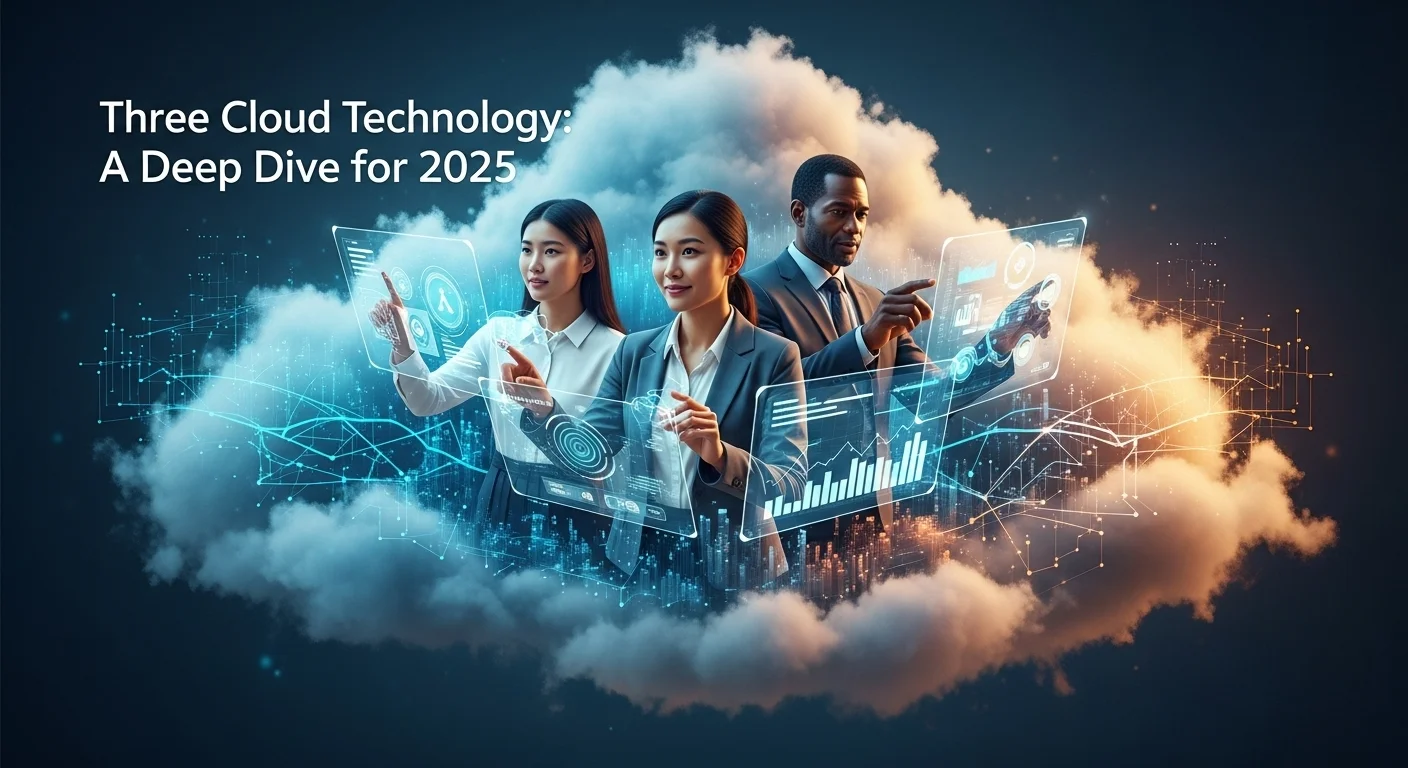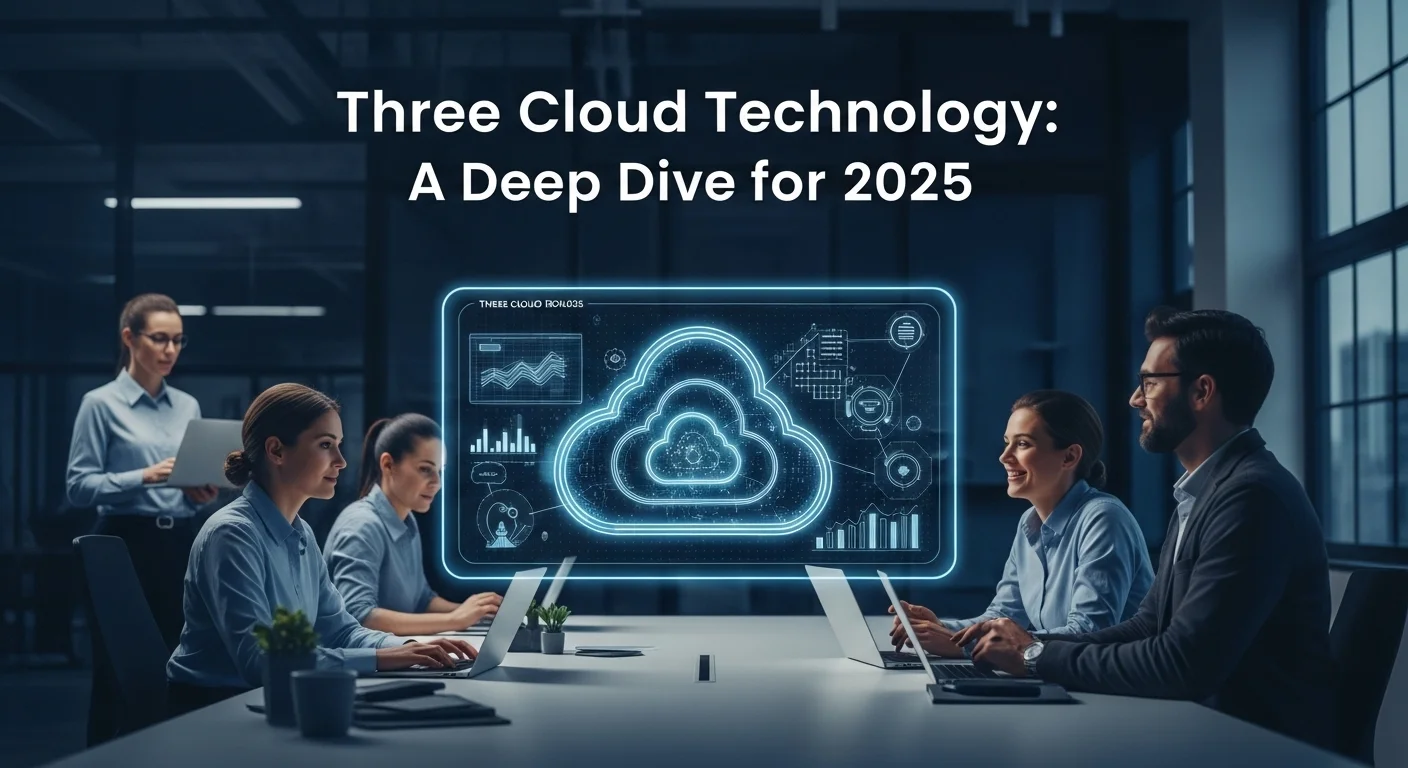The 'Big Three' Clouds: A Practical Guide to AWS, Azure, and GCP for 2025

Executive Summary
After more than a decade helping companies navigate their digital transformations, I've seen the word 'cloud' go from a vague buzzword to the engine that powers our entire digital world. When people talk about 'the cloud' today, they’re almost always talking about what I call the 'Three Cloud' ecosystem. This isn't an official term, but it perfectly captures the reality of the situation: the landscape is dominated by three major players (Amazon Web Services, Microsoft Azure, and Google Cloud) and built on three core service types (IaaS, PaaS, and SaaS). Understanding this ecosystem isn't just for tech gurus anymore; it's a critical piece of business strategy. This guide is my attempt to cut through the jargon and give you a real-world look at how these pieces fit together. We'll explore what makes each provider unique and how to choose the right services to build faster, smarter, and more efficiently.
Table of Contents
Table of Contents
- What is the 'Three Cloud' Ecosystem and Why Does It Matter?
- The Big Three: The Giants of Cloud Computing
- The Foundational Pillars: Understanding IaaS, PaaS, and SaaS
- The Real-World Impact of the Cloud Ecosystem
What is the 'Three Cloud' Ecosystem and Why Does It Matter?
In the world of technology, we love creating terms to simplify big ideas. 'Three Cloud' is a term I've found incredibly useful to describe the core of modern computing. It’s a simple way to refer to the two trinities that define the cloud: the three dominant providers and the three fundamental service models they offer. The way these elements work together has completely changed the game, giving everyone from tiny startups to global corporations access to immense computing power. Getting a handle on this concept is essential for making smart decisions about technology, whether you're a developer, a CEO, or an entrepreneur. It’s the lens through which we can understand the market, plan for the future, and find new ways to innovate.
The Big Three: The Giants of Cloud Computing
First and foremost, the 'Three Cloud' refers to the titans of the industry: Amazon Web Services (AWS), Microsoft Azure, and Google Cloud Platform (GCP). These three companies have a staggering lead in the global cloud market, collectively holding well over 60% of the market share. I've worked with them all, and their dominance isn't just about size; it’s about their relentless investment in a global network of data centers, constant R&D, and an almost unbelievable variety of services. They've built the digital roads and bridges that a huge portion of the internet runs on, allowing a business in Ohio to serve customers in Japan with minimal delay. This global presence, backed by constant innovation in hot fields like AI and data science, makes them the bedrock of the digital economy.
The Foundational Pillars: Understanding IaaS, PaaS, and SaaS
The second part of the 'Three Cloud' concept is just as important. It’s about how cloud services are delivered. I like to explain this with an analogy: building a pizza. You have three main ways to get one, and each corresponds to a cloud service model.
- Infrastructure as a Service (IaaS): This is the 'take and bake' pizza. You go to the store and buy the dough, sauce, cheese, and toppings. You have total control over the ingredients and how you cook it, but you have to provide your own oven and do all the work. In tech terms, IaaS gives you the raw computing ingredients—virtual servers, storage, and networking. You rent the hardware, but you're responsible for managing the operating system and everything on top of it. I've seen this model work perfectly for companies that need maximum flexibility or have very specific configurations for their legacy applications. The big players here are Amazon EC2, Azure Virtual Machines, and Google Compute Engine.
- Platform as a Service (PaaS): This is like getting a pizza delivered. Someone else has handled making the pizza, and they bring it to your door hot and ready. You don't have to worry about the kitchen or the oven; you just provide the plates and drinks. In the cloud world, PaaS provides a platform where you can build and run your applications without managing the underlying infrastructure. The provider handles the servers, operating systems, and development tools, so your team can focus purely on writing code. This is a dream for developers because it dramatically speeds up the process of getting an idea to market. It's the engine behind modern, agile development. Think of services like AWS Elastic Beanstalk, Azure App Service, and Google App Engine.
- Software as a Service (SaaS): This is like going out to a restaurant for pizza. You just show up, sit down, and enjoy the meal. The restaurant handles everything—the ingredients, the cooking, the service, and the cleanup. SaaS is the most hands-off model, where you simply use a complete software application over the internet, usually for a subscription fee. You don't manage anything; you just use it. We all use SaaS every day, from Google Workspace and Microsoft 365 to Salesforce and Slack. It's perfect for common business needs where a custom-built solution offers no real advantage.
It's important to remember that these aren't mutually exclusive. Most companies I work with use a mix of all three. They might use a SaaS tool for their sales team, a PaaS environment for their web app, and IaaS for some heavy-duty data processing.
The Real-World Impact of the Cloud Ecosystem
The combination of these powerful providers and flexible service models has had a profound impact on how business is done. Here's what it means in practical terms:
- Scale on Demand: I remember the old days of buying servers for your 'busiest day of the year,' which meant they sat idle 95% of the time. The cloud lets you scale resources up or down automatically. This means you can handle a sudden flood of traffic without your site crashing and save money when things are quiet.
- Smarter Spending: The cloud turns a massive upfront cost (Capital Expenditure) into a manageable monthly bill (Operational Expenditure). This has been a game-changer for startups, allowing them to compete with established players without needing millions in initial funding.
- Accelerated Innovation: The big three are in a constant race to release the coolest new tools for AI, machine learning, and data analytics. By using these as services, a small team can build incredibly sophisticated products in weeks, not years. It's like having Google's or Amazon's R&D department on your team.
- Go Global in Minutes: Building a secure, reliable global network is incredibly complex and expensive. The major providers have already done it. This lets any business deploy its application around the world, ensuring a fast and reliable experience for all users.
- Technology for Everyone: This, for me, is the most exciting part. The cloud has democratized technology. A developer in her garage can now access the same powerful tools as a Fortune 500 company, leveling the playing field and sparking innovation everywhere.
In short, the 'Three Cloud' framework is your map to the modern tech world. It shows you who the main players are and what kinds of tools they offer. Understanding this map is the first step to building a business that is agile, resilient, and ready for the future.

A Practical Guide to Cloud and Business Solutions
Choosing to use the cloud is the easy part. The real challenge is navigating the landscape to build a strategy that actually works for your business. It's about picking the right provider, mixing the right services, and creating something that is secure, affordable, and can grow with you. Let’s dive into a practical comparison of the big three and discuss how to choose the right tools for the job.
A Head-to-Head Comparison: AWS vs. Azure vs. GCP
While all three major players offer a full suite of services, they each have their own personality and strengths. I've seen clients succeed with all three, but the best choice often depends on your company's background, team skills, and goals.
Market Position and Core Strengths
- Amazon Web Services (AWS): AWS is the original pioneer and the undisputed market leader. Their biggest strength is their sheer maturity and the incredible breadth of their service catalog—they have a tool for almost anything you can imagine. I often find that startups and tech-forward companies gravitate towards AWS because of its massive community, extensive documentation, and developer-centric culture. It's seen as the reliable, comprehensive choice.
- Microsoft Azure: Azure's superpower is its deep integration with the Microsoft enterprise ecosystem. For any company that runs on Windows Server, Office 365, and Active Directory, Azure often feels like a natural extension of their existing IT. I've found it's an incredibly smooth transition for them. Microsoft has also invested heavily in hybrid cloud solutions like Azure Arc, which is a huge selling point for businesses that aren't ready to go 'all-in' on the public cloud just yet.
- Google Cloud Platform (GCP): While third in market share, GCP is a beast in its own right, especially in areas where Google has always excelled: data, analytics, machine learning, and networking. Kubernetes, the gold standard for managing containers, was born at Google, and their expertise shows. I typically recommend GCP to clients who are building cloud-native applications from the ground up or have massive data workloads. Their tools like BigQuery are often considered best-in-class.
Comparing a Few Key Services
Let's look at how their offerings stack up in a few common areas:
- Compute (IaaS): This is your virtual server. AWS has EC2, Azure has Virtual Machines, and GCP has Compute Engine. The real difference isn't in the basic offering but in the dizzying array of instance types and pricing models. My advice is to not get lost in the options; start with a general-purpose machine and monitor its performance before optimizing.
- Storage: For bulk data storage, you're looking at AWS S3, Azure Blob Storage, or Google Cloud Storage. All three are excellent and offer different price tiers based on how often you need to access your data. The key is to be disciplined about moving data to cheaper 'cold' storage when you're done with it.
- Databases: This is a complex area. All three offer managed versions of popular databases like MySQL and PostgreSQL. But they also have their own flagship products: AWS has Aurora, Azure has Cosmos DB, and GCP has Spanner. The choice here really depends on your application's specific needs for scale and consistency.
- AI/Machine Learning (PaaS/SaaS): This is where the innovation race is hottest. All three offer a spectrum of AI services. You can use simple pre-trained APIs to add vision or language understanding to your app (SaaS-like), or you can use powerful platforms like Amazon SageMaker, Azure Machine Learning, or Google's Vertex AI to build and train your own custom models (PaaS).
Business Techniques: Choosing the Right Service Model
The decision between IaaS, PaaS, and SaaS is a strategic one that directly impacts your budget, agility, and control.
- When to Choose IaaS: I recommend IaaS when you need total control. This is often the case when you're migrating an older, complex application to the cloud (a 'lift-and-shift') or have strict security requirements that demand granular control over the network and operating system. The trade-off is that your team is responsible for more of the management.
- When to Choose PaaS: PaaS is all about speed. If you're building a new application and want your developers focused on writing features, not managing servers, PaaS is the way to go. It's the foundation of a modern, agile development culture.
- When to Choose SaaS: Use SaaS for everything else! For standard business functions like email, HR, or CRM, building your own tool is a waste of time and money. The benefits of low cost, zero maintenance, and instant access are just too compelling. The compromise is that you give up control over the feature roadmap and customization.
Unlocking Business Value: Multi-Cloud and Hybrid Cloud Strategies
These days, the smartest strategy often isn't about picking one provider. Most large companies I work with are using a multi-cloud or hybrid approach.
- Multi-Cloud: This just means using services from more than one public cloud provider. The main reasons are to avoid being locked into a single vendor and to use the 'best-of-breed' service for each task. For example, you might run your web applications on AWS but use GCP's BigQuery for your data analytics. It adds management complexity, but for many, the flexibility is worth it.
- Hybrid Cloud: This approach combines your on-premises data center with a public cloud. It's the perfect solution for companies with data that, for regulatory or privacy reasons, can't leave their building. It allows them to keep sensitive data local while still taking advantage of the public cloud's scalability for other workloads. Tools like AWS Outposts, Azure Arc, and Google Anthos are making this easier than ever to manage.
By thinking critically about which of the big three providers to use and strategically choosing between IaaS, PaaS, and SaaS, you can create solutions that are powerful and perfectly tailored to your business goals. The question is no longer *if* you should use the cloud, but *how* you can best leverage this incredible ecosystem to innovate.

Tips and Strategies to Master Your Cloud Experience
Getting onto the cloud is just the beginning. The real magic happens when you start to optimize. To get the most out of AWS, Azure, or GCP, you need a solid plan for managing costs, security, and performance. Here are some of the most important tips and strategies I share with my clients, along with a look at what's coming next.
Best Practices for Cloud Management
Think of cloud management as a continuous loop: monitor, analyze, and optimize. It revolves around three critical pillars.
1. Master Your Cloud Bill (FinOps)
I can't tell you how many times I've seen a company's cloud bill double because a dev team forgot to shut down a massive test environment over the weekend. Cloud spending can get out of hand fast without discipline. This is where FinOps comes in—it's a cultural shift to make everyone accountable for the costs they incur.
- Right-Size and Shut Down: Your cloud provider gives you the tools to see exactly which resources are being used. Use them! Regularly check for oversized servers and shut down anything that's not being used. It's the easiest way to save money.
- Use the Right Pricing Model: Don't just pay the default on-demand price. For servers that you know will be running 24/7, commit to a one- or three-year plan (Reserved Instances or Savings Plans) to get massive discounts. For tasks that can be interrupted, like data processing, use Spot Instances to save up to 90%.
- Automate Shutdowns: This is a simple but powerful trick. Set up automated scripts to turn off all development and testing environments at 7 PM and on weekends. This alone can cut your non-production costs in half.
- Tag Everything: This is non-negotiable. Enforce a strict policy where every single resource is 'tagged' with its owner, project, or department. Without tags, you have no idea who is spending what, and you can't build accountability.
2. Fortify Your Security
I always explain cloud security with this analogy: the provider is responsible for securing the apartment building (physical security, access), but you are responsible for locking your own apartment door (your data, access, and configurations). It’s a shared responsibility.
- Use the Principle of Least Privilege: This is security 101. Grant users and applications only the exact permissions they need to do their job, and nothing more. Never use your main 'root' account for daily tasks.
- Encrypt Data Everywhere: Encrypt your data when it's sitting in storage (at rest) and when it's moving over the network (in transit). All three major providers make this incredibly easy, so there's no excuse not to.
- Lock Down Your Network: Use Virtual Private Clouds (VPCs) to create isolated sections of the cloud for your applications. Use security groups (virtual firewalls) to strictly control what traffic is allowed in and out.
- Use AI for Security: The providers offer amazing tools like AWS GuardDuty and Azure Sentinel that use machine learning to detect suspicious activity. Turn them on. They can spot threats that a human would miss.
3. Ensure Peak Performance
- Design for Scale: Build your applications to scale horizontally. Use auto-scaling groups to automatically add more servers when traffic spikes and remove them when it dies down. A load balancer will distribute the traffic evenly, ensuring a smooth experience for your users.
- Don't Have a Single Point of Failure: For important applications, deploy them across multiple Availability Zones (AZs). An AZ is a separate data center within the same region, so if one has an issue, your app stays online. For ultimate resilience, you can even design for a multi-region architecture.
Advanced Strategies: DevOps and Cloud-Native
To truly unlock the agility of the cloud, you need to modernize how you build and run software. This means embracing DevOps and building 'cloud-native' applications.
- DevOps in the Cloud: DevOps is all about breaking down the walls between development and operations teams to ship better software, faster. The cloud is the ultimate enabler for this.
- Infrastructure as Code (IaC): Instead of manually clicking around a console, define your entire infrastructure in code using tools like Terraform or AWS CloudFormation. This makes your environments reproducible, version-controlled, and easy to manage.
- CI/CD Pipelines: Automate your entire release process. When a developer pushes code, a pipeline should automatically build, test, and deploy it. Services like AWS CodePipeline, Azure Pipelines, and Google Cloud Build are designed for this.
- Cloud-Native Development: This means building applications specifically to take advantage of the cloud's unique nature. The key technologies are:
- Containers (Docker): These package your application and all its dependencies into a single, portable unit that can run anywhere.
- Container Orchestration (Kubernetes): Kubernetes (K8s) is the universal standard for managing containerized applications at scale. The managed services (EKS, AKS, GKE) from the big three make running K8s much simpler.
- Serverless Computing (FaaS): This is the next evolution. With services like AWS Lambda or Azure Functions, you can run your code without thinking about servers at all. You just upload your code, and it runs when needed. It’s incredibly cost-effective and perfect for event-driven tasks.
Future-Proofing Your Strategy
The cloud never stands still. Here’s what I’m keeping my eye on:
- AIOps: AI is increasingly being used to manage the cloud itself, from predicting costs to automatically fixing performance issues before they impact users.
- Edge Computing: As the Internet of Things (IoT) grows, more computing is happening at the 'edge'—closer to the devices themselves. The cloud providers are extending their platforms to manage these edge devices seamlessly.
- Sustainability: The environmental impact of data centers is a growing concern. The major providers are investing heavily in renewable energy. You can now even choose your cloud region based on its carbon footprint, which is becoming a key part of corporate responsibility.
By applying these strategies, you can move beyond simply using the cloud as a remote hard drive and turn it into a true catalyst for innovation. The journey is ongoing, but the potential is limitless. For more technical details, I always point people to the excellent documentation from the providers themselves, like the AWS Whitepapers & Guides, which are a goldmine of best practices.
Expert Reviews & Testimonials
Sarah Johnson, Business Owner ⭐⭐⭐
As a small e-commerce owner, the information was solid, but I'd love to see a case study on how a business like mine can choose between the different services. Still, a good starting point.
Mike Chen, IT Consultant ⭐⭐⭐⭐
As an IT consultant for SMBs, this is a great resource. It clearly breaks down the pros and cons of the big players. Could use a bit more on the multi-cloud management tools, but overall very helpful.
Emma Davis, Tech Expert ⭐⭐⭐⭐⭐
Fantastic article! As a DevOps engineer, I appreciate the detailed look at how CI/CD pipelines and IaC fit into the different cloud ecosystems. This is a must-read for anyone in the field.



